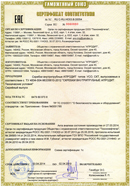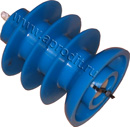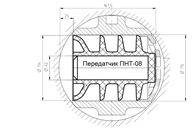Caliper PIGs of SKT line
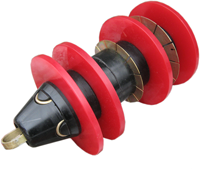
Caliper PIGs are designed for detection of narrowings in a pipeline before cleaning or inspection PIGs are launched in the pipeline.
Due to their ability to pass narrowings 65% of outer pipe diameter the SKT PIGs can pass the most difficult sections of the pipeline without any stop.
Deformations of installed on the PIG metallic measuring discs will give the information about presence of narrowings in the pipeline which can stop a form-measuring or cleaning PIG. Such places of the pipeline (if found by SKT pig) should be repaired.
SKT caliper PIG can be supplied with low-frequency transmitter and without it. Presence of the transmitter enables to trace how the PIG moves inside a pipeline. And in case the PIG stops somewhere in the pipeline then there are 40 days to find it with use of low-frequency locator while the transmitter emits signals.
By the amount of debris carried by SKT caliper PIG into receiving chamber it is possible to evaluate the scale of pigging which will be necessary to clean the pipeline.
Proved solutions
Dimensions of SKT PIG body and geometrical parameters of polyurethane discs were selected in the way to allow passage of the PIG through the following peculiarities of a pipeline:
- Narrowings up to 65% of outer diameter of the pipeline
- Pipe bends 90 degrees with radius 1.5 Dn (according to GOST 17375-2001)
- Equal diameter T-joints without grid with lower position of the joining pipe
- Smaller diameter pipes protruding inside the pipeline (plungers)
- V-valves and gate valves
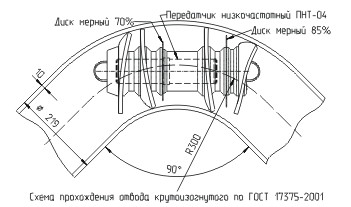
Parts composing the body of the PIG are manufactured as thick-walled parts and made of strong plastic. Carrying and simultaneously cleaning discs are made of wear resistant polyurethane with Shore hardness 75...85.
In-line caliper PIGs of SKT series were certified in accordance with TR CU 010/2011 "On the safety of machinery and equipment".
Certificate of Conformity of the Customs Union - a document certifying the conformity of products with technical regulations and providing of certified products in Russia, Belarus and Kazakhstan without additional requirements and without additional assessment procedures.
We manufacture SKT pigs for pipelines with a diameter from 80mm to 1420mm. Each such pig can be equipped with low frequency transmitter . At the same time, the stated above passability of the bore and features of the pipeline is ensured.
Body parts for pipelines up to 530 mm in diameter are made of solid polyurethane or caprolon. It is more economical to make the bodies of pig-calibers for pipelines with a diameter of more than 530 mm from steel. For small-diameter interfield pipelines, we manufacture solid pistons with the passability of the bore as in the SKT series pigs.
For any piston or pig body design, polyurethane cleaning discs or cuffs that directly clean the pipeline walls are made only of high-quality wear-resistant polyurethane with a hardness of 75 to 85 Shore A. This guarantees a consistent, high quality cleaning with minimal wear.
Ordering SKT PIGs
In case of caliper PIG ordering please write SKT-XXX-T, where XXX should be nominal diameter of the pipeline in millimeters.
Specify T when the PIG is ordered with transmitter. In case the PIG is ordered without transmitter then T in the name is not written.
Example: Caliper PIG of SKT line for launching in a pipeline which linear part is made of pipes with outer diameter 325 mm (diameter orifice Dу=300 mm), equipped with low-frequency transmitter PNT-00 (without telemetric module) will be described as caliper PIG SKT-300-T.
Diameters of measuring (caliper) discs are determined based on outer diameter of the pipeline. Usually two measuring discs are installed 85% and 70% of outer diameter.
For works in pipelines with thick walls (15mm and more) it is necessary to provide us information about the pipes wall thickness.
Additional features
Indicators of bend radius of the IRT series
Diagnostic multi-section pigs are designed to pass 90 degree bends (bends) of the pipeline with a certain minimum radius, for example R = 3.0 DN. If the retraction radius is smaller (for example, R = 1.5 DN or R = 1.2 DN), then the inspection tool will get stuck in this place. Therefore, it is very important, before starting, to be sure that the radius of all branches of a given pipeline is not less than the minimum radius for which a specific inspection tool or cleaning PIG (piston) is designed.
With the help of the SKT caliper PIG with measuring discs, it is possible to determine not only the maximum constriction in the pipeline, but also the minimum radius of the pipeline bend (bend). To do this, it is necessary to supplement the standard gauging pig of the SKT series with a special mechanical indicator of the radius of the branches of the IRT series, which is installed in the rear part of the pig.
The principle of operation of the IRT radius indicator is based on the fact that during the run in the bends with a small bending radius, deformations of the petals of a special measuring disk made of plastic metal occur. This disc is located on a special leash behind the gauging pig, which is hingedly connected to the pig body. After running through the pipeline, the deformations of the petals of this disc are compared with the tabular values to determine the minimum radius of the bend passed by the pig-gauge in this pipeline.
When designing the IRT radius indicator for each pipeline diameter, its geometric parameters are calculated on the basis of computer finite element modeling of deformations of polyurethane collars (or disks), which compact and center the pig-gauge in the pipeline and when passing outlets.
Usually the geometrical dimensions and arrangement of the measuring disc on the IRT leash are selected so that:
- disc petals remained undeformed if all bends were with radius R> 3.0 DN;
- one bend appears on the petals if 1.5 DN <R <3.0 DN (in this case, a more accurate value of R can be determined by the value of the maximum bend and the table given in the manual for IRT)
- a second bend appears on the petal if the pig-gauge has passed through the bend with a radius R <1.5DN (a more accurate value of R can also be determined from the table).
Thus, using the SKT pig-gauge with the IRT radius indicator, it is possible to determine not only the maximum critical all-round or one-sided narrowing in the pipeline, but also the minimum flow radius of the most critical branch in the pipeline.
A special measuring disc for determining the radii of the bends can be adjusted to other values than 3.0DN and 1.5 DN.
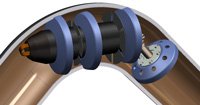
Radius indicator IRT for pigs-calibers of SKT series
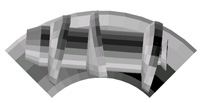
Deformations of polyurethane cuffs in the FE model of a pig
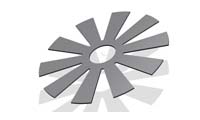
R > 3.0 DN
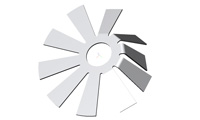
1.5 DN < R < 3.0 DN
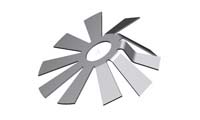
R<1.5 DN
Optimal housing design
A low-frequency transmitter can be installed inside the SKT gauging pig with a housing made of solid polyurethane (or caprolon). Unlike steel, these housing materials do not attenuate the transmitter's electromagnetic signal (magnetic field pulsating at 22Hz). This means that the detection range of a low-frequency locator of a signal from a transmitter located completely inside the body of such a pig does not decrease. This solution allows to reduce the size and weight of the gauging pig and thereby increase its passability.
Scraper-caliber bodies for pipelines with a diameter of more than 530mm are more economically profitable to be made of steel. With this design, it is necessary to move the transmitter half of its length from the PIG of the metal case. This is done to prevent strong attenuation of the electromagnetic signal from the transmitter by the PIG of the pig (for a more detailed explanation, see here ). In this case, using a bumper, it is necessary to protect the transmitter from possible damage.
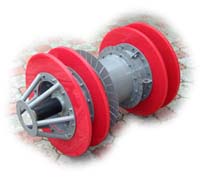
Scrape- caliber SKT-700 with a metal body and PNT-00 transmitter, which is protected by a metal bumper made of pipes
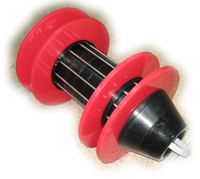
Cleaning PIG SKT-500 (without calibration discs)
PNT-01 transmitter with telemetry module
When installing the transmitter PNT-01 with a telemetry module, the impact of the measuring discs on the pipeline narrowing are recorded in the transmitter's internal memory with a time reference. This allows you to assess the location of obstacles along the length of the pipeline and reduces the time to find and remove restrictions.
Cleaning pipelines with significant restrictions
Sometimes, for cleaning "difficult" pipelines, where there are restrictions greater than 15% of the diameter (flow area less than 85% of D out ), pigs with good permeability are required. For example, if the flow area of the pipeline for some reason is only 70% of the external nominal diameter, then for such cases we offer SKT series pigs without installed calibration discs. The degree of cleaning of the inner surface of the pipeline of such pigs will be lower than that of the cleaning USO series pigs . But the risk of the pig getting stuck in such a pipeline is greatly reduced.
Instead of cleaning polyurethane discs, you can always install polyurethane cuffs on SKT pigs.
Scrapers for starting through 3-way ball valves
It is possible to manufacture shortened SKT pigs with a solid polyurethane body or solid polyurethane pistons for starting (including automatic) from a three-way full-bore ball valve.
Such pigs can be equipped with a PNT low-frequency transmitter to track and locate the pig while moving through the pipeline.
The illustration shows a short pig with a transmitter for a three-way ball valve in a pipeline DN = 300 mm and a one-piece pig with a transmitter for a pipeline DN = 100 mm.
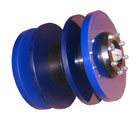
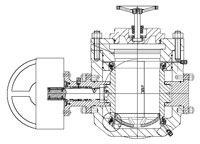
Telescopic piping solution
On the basis of SKT pigs, we have developed a series of in-line telescopic pigs that are used to clean pipelines with sections with different nominal pipe diameters (telescopic pipelines). SKT pig-telescopes pass bends with a radius of R = 1.5D and narrowing 70% D in a pipe with a larger diameter and R = 3.0D, 85% D in a pipe with a smaller diameter.
Thanks to the split discs, the pig-telescope is well sealed in both small and large pipes. High-quality cleaning of small-diameter pipelines is achieved thanks to 2 solid discs of a smaller diameter. Thus, the SKT series pigs can clean a telescopic pipeline in which other pigs are not applicable.
For example, to clean a pipeline assembled from pipes with an outer diameter of 219mm and 273mm, a pig telescope is used, designated when ordering - SKT-200-250.
A PNT series transmitter can also be installed in the SKT pig telescope to track its movement inside the pipeline.
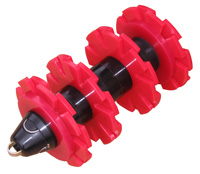
Scraper SKT-200-250, used to clean the pipeline assembled from pipes with a diameter of 219 mm and 273 mm.
Installation of PPNT transceiver
Instead of a low-frequency PNT transmitter, a low-frequency PNT transceiver can be installed in the pig, which has the same mounting dimensions. A special feature of the transceiver is that it can be "put to sleep" (put into the mode of minimum power consumption) by a special command transmitted through the metal walls of the closed launch chamber. In this case, the pig with the transceiver can be inside the launch chamber under pressure for several days or even weeks. After that, it can be turned on with a similar command at a frequency of 22 Hz. Then it will continue to work as a conventional 22 Hz transmitter. This does not require opening the launch camera.
To transmit a command through thick-walled closed metal (or reinforced concrete) walls, an emitter is used, which also operates at a frequency of 22 Hz. A modified PNT-04 transmitter is used as an emitter (remote control).
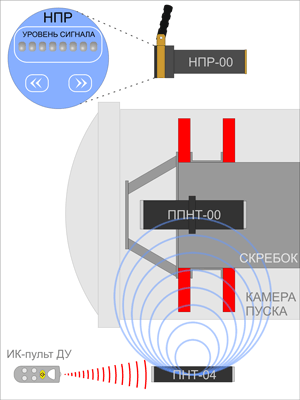
Other configurations of SKT pigs
Due to the collapsible body made of polyurethane (or coprolon) bushings, various modifications and configurations of SKT pigs are possible, including changing the number and location of polyurethane cleaning and backing discs, installing various additional equipment, magnets and brushes.
Advantages of collapsible pigs with non-metallic body
The main advantage of inline PIGs with a non-metallic collapsible body is a significant reduction in the risk of damage to pipeline valves in the event that for some reason they were not fully open during the passage of the pig.
Compared to solid polyurethane pistonsDue to the collapsible body made of polyurethane (or coprolon) bushings, various modifications and configurations of SKT pigs are possible, including changing the number and location of polyurethane cleaning and backing discs, installing various additional equipment, magnets and brushes. , small-diameter pigs with polyurethane cleaning discs and an easily disassembled non-metallic body have a definite distance advantage. That is, along the total length of the pipeline, which can be cleaned with their help.
This is due to the fact that small-diameter pigs are usually used several times to clean short (up to 50 km) or infield pipelines. Before the next launch into the pipeline, the pigs are cleaned of the deposits they carry. Thus, with repeated use of pigs, it is possible to inspect and individually replace particularly worn discs.
If the edge of the cleaning disc is worn, the disc can be turned over and placed back on the pig. The disc can then be used to clear almost the same distance. After inspection, it is also possible to swap the most and least worn discs as part of the pig or replace a specific badly damaged disc. This work of inspection and selective replacement or inversion of cleaning discs requires a certain investment of time from the personnel. But this can significantly increase the efficiency of using polyurethane products.
Making spare polyurethane discs is also easier and cheaper than making solid polyurethane pistons . After all, the body practically does not wear out. Many suppliers can supply quality replacement polyurethane wheels.
Thus, the organization operating the pipeline can significantly reduce its costs of in-line cleaning by using pigs with cleaning discs and a collapsible body.

